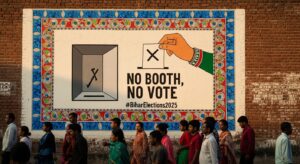
Two Indian states just achieved the impossible: infant mortality rates lower than America’s. Manipur and Kerala, with limited resources but unlimited determination, have rewritten global health rankings, proving that innovation trumps wealth in saving lives. Their secret formula is transforming how the world thinks about healthcare delivery.
In a stunning reversal of global health narratives, two Indian states have achieved what seemed impossible just decades ago, infant mortality rates that surpass those of the United States. While America grapples with an IMR of approximately 5.8 deaths per 1,000 live births, Manipur has achieved a remarkable 3 per 1,000, with Kerala close behind at 5. This extraordinary achievement represents not just statistical progress, but a fundamental reimagining of what’s possible when targeted healthcare interventions meet unwavering political commitment.
The Great Transformation: From Crisis to Triumph
India’s infant mortality journey reads like a phoenix rising from ashes. In 1950, a staggering 189.63 infants died for every 1,000 born,nearly one in five newborns never saw their first birthday. The trajectory seemed insurmountable: 150.60 in 1960, 135.80 in 1970, 108.40 in 1980. Yet by 2023, India achieved its historic low of 25 per 1,000 live births, representing a 37.5% decline from 40 in 2013 alone.
This transformation mirrors the broader demographic transition that has reshaped Indian society. Birth rates plummeted from 36.9 in 1971 to 18.4 in 2023, while death rates fell from 14.9 to 6.4 over the same period. Rural areas, traditionally lagging in health outcomes, witnessed particularly dramatic improvements, with death rates declining from 7.2 in 2022 to 6.8 in 2023.
The Manipur Miracle: Lessons from India’s Northeast
Manipur’s achievement of a 3 per 1,000 IMR, lower than many developed European nations, offers fascinating insights into healthcare innovation. Despite being a smaller state with limited resources, Manipur demonstrates that geographical size need not dictate health outcomes. The state’s success likely stems from several factors: concentrated healthcare delivery systems that can respond quickly to community needs, strong community participation in health initiatives, and the ability to implement targeted interventions without the bureaucratic complexities that plague larger states.
The state’s achievement becomes even more remarkable when contrasted with China’s highly acclaimed IMR of 4.5, Manipur has surpassed even this benchmark. This suggests that effective healthcare delivery isn’t solely about economic resources but about strategic implementation and community engagement.
Kerala: The Enduring Healthcare Pioneer
Kerala’s consistent performance, maintaining an IMR of 5 while serving a population of over 35 million, represents perhaps the most sustainable model for other states. The state’s success rests on what researchers call “adequate provision of basic health facilities.” This isn’t about high-tech interventions or expensive procedures; it’s about ensuring fundamental healthcare reaches every corner of society.
Kerala’s healthcare infrastructure reads like a public health textbook come to life: widespread networks of primary health centres extending to remote areas, emphasis on institutional deliveries (over 80% nationally, likely higher in Kerala), comprehensive maternal and child health services, robust immunization programs, and critically, high literacy rates that enable communities to make informed health decisions.
The Policy Architecture: National Programs Driving Change
India’s success hasn’t occurred in a vacuum but through deliberate policy interventions. The Janani Suraksha Yojana (JSY), a conditional cash transfer scheme achieving 87% utilization in FY24, has revolutionized maternal healthcare access. The Janani Shishu Suraksha Karyakram (JSSK) provides free maternal and neonatal services, while the National Health Mission coordinates these efforts at scale.
These programs have achieved remarkable institutional delivery rates—over 80% nationally—ensuring that births occur in healthcare facilities with skilled attendants, dramatically reducing risks for both mothers and infants.
The Stark Disparities: A Tale of Two Indias
Yet India’s success story remains incomplete. States like Chhattisgarh, Madhya Pradesh, and Uttar Pradesh report IMRs of 37, more than twelve times higher than Manipur’s rate. This disparity reveals a troubling reality: India contains within itself both world-class healthcare outcomes and developing-world challenges.
The rural-urban divide compounds these challenges. While urban areas achieved an IMR of 18 in 2023 (down from 27 in 2013), rural areas lag at 28 (down from 44 in 2013). These numbers tell the story of two healthcare ecosystems operating within the same national framework.
Challenges for Larger States: Scale Versus Efficiency
Larger states face unique challenges that smaller states like Manipur can sidestep. Population density, resource distribution, administrative complexity, and the sheer scale of service delivery create implementation bottlenecks. Uttar Pradesh, with over 200 million residents, must coordinate healthcare delivery across a population larger than Brazil’s, while managing diverse socio-economic conditions and geographical challenges.
The lesson isn’t that large states are doomed to poor performance: China’s success with 1.4 billion people proves otherwise, but that they require different strategies. China’s achievement of near-universal hospital deliveries (above 99%) suggests that systematic, standardized approaches can work at scale.
Learning from Success: The Replicable Elements
Several elements from Kerala and Manipur’s success appear replicable. First, community participation emerges as crucial,leveraging accredited social health activists who “play a vital role in connecting with pregnant women within communities.” Second, emphasis on institutional deliveries with skilled attendants provides measurable impact. Third, comprehensive basic healthcare infrastructure ensures that interventions reach those who need them most.
The education component cannot be understated. Kerala’s high literacy rates enable communities to understand health information, seek appropriate care, and make informed decisions about maternal and child health.
The Development Dividend: Beyond Health Statistics
Lower infant mortality rates catalyze broader developmental progress. They indicate effective healthcare systems, educated populations, and responsive governance, all prerequisites for sustained economic growth. Countries and states with low IMRs typically exhibit higher human development indices, better educational outcomes, and more robust economic growth.
For India’s aspirations toward developed nation status by 2047, addressing IMR disparities becomes not just a humanitarian imperative but an economic necessity. The human capital preserved through reduced infant mortality, the engineers, doctors, teachers, and entrepreneurs who survive their first year, represents the foundation of future prosperity.
Writing Tomorrow’s Success Story
India’s infant mortality achievements, led by Manipur and Kerala, demonstrate that world-class health outcomes are achievable regardless of economic constraints. The challenge now lies in scaling these successes to India’s larger, more complex states while maintaining the community engagement and systematic delivery that made these achievements possible.
As India approaches its centenary of independence in 2047, the path forward is illuminated by the success of its smallest states. The question isn’t whether India can achieve universal low infant mortality, Manipur and Kerala have proven it possible. The question is whether India has the political will and administrative capability to make their exceptional achievements the national norm.
In surpassing American infant mortality rates, these Indian states haven’t just achieved statistical milestones, they’ve redefined what’s possible in global health, proving that innovation, commitment, and community engagement can triumph over resource constraints and geographical challenges.


